Real Service at Mill Valley Car Wash to Day,
the Head Lights a Fact,
sun to that is this fraction of the Divide on Mathematical to a Rainy Day!!
Thanks so much,
great Experience and I had an enjoyable visit too!!
The Farmer's Market in the Parking Lot of CVS location Locale,
fun to see a fantastic Dish,
*kimchi my Favorite Memory to a Name's Noun,
payphones and the laughter Once the Coin for that long Distant strange,
wondering how the Muscle clams as Aye know a girl by the Answer,
Hey Fletch!!
smiles and grins,
love the private sea to speak a special Tenderloin,
coffee tables Television tell that Popcorn pick Key person that its. . . .
just love.
Kimchi
From Wikipedia, the free encyclopedia
This article is about the Korean dish. For people with this surname, see Kimhi. For other uses, see kimchi (disambiguation).
| Kimchi | |
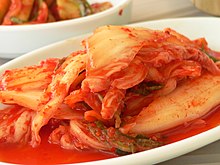 | |
| Korean name | |
|---|---|
| Hangul | 김치 |
| Revised Romanization | Gimchi |
| McCune–Reischauer | Kimch'i |
Kimchi (Hangul: 김치, Korean: [kimtɕʰi]; English /ˈkɪmtʃi/), also spelled kimchee or gimchi, is a traditional fermented Korean side dishmade of vegetables with a variety of seasonings.[1][2] In traditional preparation, kimchi was stored underground in jars to keep cool during the summer months and unfrozen during the winter months.[3] There are hundreds of varieties of kimchi made from napa cabbage, radish, scallion, or cucumber as a main ingredient.[4]
Contents
[hide]History[edit]
The term ji was used until the pre-modern terms chimchae, dimchae, and timchae were adopted in the period of the Three Kingdoms of Korea.[5] The word then was modified into jimchi, and is currently kimchi.
Red chili pepper flakes are now used as the main ingredient for spice and source of heat for many varieties of kimchi. In the twelfth century other spices, creating flavors such as sweet and sour, and colors, such as white and orange, were added.[6]
Kimchi is Korea's national dish. During South Korea's involvement in the Vietnam War its government requested American help to ensure that South Korean troops, reportedly "desperate" for the food, could obtain it in the field;[7] South Korean president Park Chung-hee told U.S. President Lyndon B. Johnson that kimchi was "vitally important to the morale of Korean troops".[3] It was also sent to space on board Soyuz TMA-12 with Yi So-yeon after a multimillion-dollar research effort to kill the bacteria and lessen the odor without affecting taste.[7]
Main ingredients[edit]
Kimchi varieties are determined by the main vegetable ingredients and the mix of seasonings used to flavor the kimchi.
The Kimchi Field Museum in Seoul has documented 187 historic and current varieties of kimchi. Ingredients can be replaced or added depending on the type of kimchi being made. The most common seasonings include brine, scallions, spices, ginger, chopped radish,garlic, saeujeot (새우젓, shrimp sauce), eoriguljeot (어리굴젓, oyster sauce), and aekjeot (액젓, fish sauce).
Varieties[edit]
Kimchi can be categorized by main ingredients, regions or seasons. Korea's northern and southern sections have a considerable temperature difference.[8] There are over 180 varieties of kimchi.[9] The most common kimchi variations are baechu kimchi (배추김치, napa cabbage kimchi), baechu geotjeori (배추겉절이, unfermented napa cabbage kimchi), bossam kimchi (보쌈김치), baek kimchi (백김치, white kimchi), dongchimi (동치미, water-based kimchi), chonggak kimchi (총각김치, young radish kimchi), kkakdugi (깍두기, daikon kimchi), oisobagi (오이소박이, cucumber kimchi), and pa kimchi (파김치, green onion kimchi).
Kimchi from the northern parts of Korea tend to have less salt and red chilli and usually do not include brined seafood for seasoning. Northern kimchi often has a watery consistency. Kimchi made in the southern parts of Korea, such as Jeolla-do and Gyeongsang-do, uses salt, chili peppers and myeolchijeot (멸치젓, brined anchovy allowed to ferment) or saeujeot (새우젓, brined shrimp allowed to ferment),myeolchiaekjeot (멸치액젓), kkanariaekjeot (까나리액젓), liquid anchovy jeot, similar to fish sauce used in Southeast Asia, but thicker.
Saeujeot (새우젓) or myeolchijeot is not added to the kimchi spice-seasoning mixture, but is simmered first to reduce odors, eliminate tannic flavor and fats, and then is mixed with a thickener made of rice or wheat starch (풀). This technique has been falling into disuse for the past forty years.
White kimchi (baek kimchi) is baechu (napa cabbage) seasoned without chili pepper and is neither red in color nor spicy. White radish kimchi (dongchimi) is another example of a kimchi that is not spicy. The watery white kimchi varieties are sometimes used as an ingredient in a number of dishes such as cold noodles in dongchimi brine (dongchimi guksu).
Regions[edit]
This regional classification dates back to 1960s and contains plenty of historical facts, but the current kimchi-making trends in Korea are generally different from those mentioned below.[8]
- Pyongan-do (North Korea, outside of Pyongyang) Non-traditional ingredients have been adapted in rural areas due to severe food shortages.
- Hamgyeong-do (Upper Northeast): Due to its proximity to the ocean, people in this particular region use fresh fish and oysters to season their kimchi.
- Hwanghae-do (Midwest): The taste of kimchi in Hwanghae-do is not bland but not extremely spicy. Most kimchi from this region has less color since red chili flakes are not used. The typical kimchi for Hwanghae-do is called hobakji (호박지). It is made with pumpkin (bundi).
- Gyeonggi-do (Lower Midwest of Hwanghae-do)
- Chungcheong-do (Between Gyeonggi-do and Jeolla-do): Instead of using fermented fish, people in the region rely on salt and fermentation to make savory kimchi. Chungcheong-do has the most varieties of kimchi.
- Gangwon-do (South Korea)/Kangwon-do (North Korea) (Mideast): In Gangwon-do, kimchi is stored for longer periods. Unlike other coastal regions in Korea, kimchi in this area does not contain much salted fish.
- Jeolla-do (Lower Southwest): Salted yellow corvina and salted butterfish are used in this region to create different seasonings for kimchi.
- Gyeongsang-do (Lower Southeast): This region's cuisine is saltier and spicier. The most common seasoning components includemyeolchijeot (멸치젓) which produce a briny and savory flavor.
- Foreign countries: In some places of the world people sometimes make kimchi with western cabbage and many other alternative ingredients such as broccoli.[10][11]
Seasons[edit]
Different types of kimchi were traditionally made at different times of the year, based on when various vegetables were in season and also to take advantage of hot and cold seasons before the era of refrigeration. Although the advent of modern refrigeration — including kimchi refrigerators specifically designed with precise controls to keep different varieties of kimchi at optimal temperatures at various stages of fermentation — has made this seasonality unnecessary, Koreans continue to consume kimchi according to traditional seasonal preferences.[12]
Spring[edit]
After a long period of consuming gimjang kimchi (김장김치) during the winter, fresh potherbs and vegetables were used to make kimchi. These kinds of kimchi were not fermented or even stored for long periods of time but were consumed fresh.
Summer[edit]
Summer radishes and cucumbers are summer vegetables made into kimchi, yeolmu kimchi (열무김치) which is eaten in several bites. Brined fish or shellfish can be added, and freshly ground dried chili peppers are often used. They eat it during the summer.
Autumn[edit]
Baechu kimchi is prepared by inserting blended stuffing materials, called sok (literally inside), between layers of salted leaves of uncut, whole Napa cabbage. The ingredients of sok (속) can vary, depending on the different regions and weather conditions. Generally, baechu kimchi used to have a strong salty flavor until the late 1960s, before which a large amount of myeolchijeot or saeujeot had been used.
Gogumasoon Kimchi is made from sweet potato stems.
Winter[edit]
Traditionally, the greatest varieties of kimchi were available during the winter. In preparation for the long winter months, many types of kimjang kimchi (김장 김치) were prepared in early winter and stored in the ground in large kimchi pots. Today, many city residents use modern kimchi refrigerators offering precise temperature controls to store kimjang kimchi. November and December are traditionally when people begin to make kimchi; women often gather together in each other's homes to help with winter kimchi preparations.[13] "Baechu kimchi" is made with salted baechu filled with thin strips of radish, parsley, pine nuts, pears, chestnuts, shredded red pepper, manna lichen (Hangul: 석이 버섯; RR: seogi beoseot), garlic, and ginger.
Nutrition and health[edit]
South Koreans consume 40 pounds (18 kg) of kimchi per person annually,[14] and many credit their industrious energy as a people, and its impact on their nation's rapid economic growth, in part to eating the dish.[7] Kimchi is made of various vegetables and contains a high concentration of dietary fiber,[15][16] while being low in calories. One serving also provides over 50% of the daily recommended amount ofvitamin C and carotene. Most types of kimchi contain onions, garlic, ginger, and chilli peppers, all of which are salutary. The vegetables used in kimchi also contribute to its overall nutritional value. Kimchi is rich in vitamin A, thiamine (B1), riboflavin (B2), calcium, and iron,[17][18] and contains lactic acid bacteria, among those the typical species Lactobacillus kimchii.[19][20][21]
During the 2003 SARS outbreak in Asia many people believed that kimchi could protect against infection and while there was no scientific evidence to support this belief, kimchi sales rose by 40%.[22][14]
| Nutrients | per 100 g | Nutrients | per 100 g |
|---|---|---|---|
| Food energy | 32 kcal | Moisture | 88.4 g |
| Crude protein | 2.0 g | Crude lipid | 0.6 g |
| Total sugar | 1.3 g | Crude fiber | 1.2 g |
| Crude ash | 0.5 g | Calcium | 45 mg |
| Phosphorus | 28 mg | Vitamin A | 492 IU |
| Vitamin B1 | 0.03 mg | Vitamin B2 | 0.06 mg |
| Niacin | 2.1 mg | Vitamin C | 21 mg |
Dishes made with kimchi[edit]
Kimchi can be made with white radishes, mustard greens, scallions, or cucumbers. Kimchi is known to be a traditional side dish as it is almost always served along with other side dishes in most Korean family households and restaurants. Kimchi can be eaten alone or with white rice, but it is also included in recipes of other traditional dishes, including porridges, soups, and rice cakes. (Jung, C.) Kimchi is also the basis for many derivative dishes such as kimchi stew (김치찌개; gimchi jjigae), kimchi pancake (김치부침개; gimchijeon), kimchi soup (김칫국; gimchiguk), and kimchi fried rice (김치볶음밥; gimchi bokkeumbap).
Recent history[edit]
1996 Japanese kimchi dispute[edit]
In 1996, Korea protested against Japanese commercial production of kimchi arguing that the Japanese-produced product (kimuchi) was different from kimchi (in particular, Japanese kimuchi was not fermented so it was salted but sweet cabbage and it was not better for health than just cabbage). Additionally most ordinary people in Japan agree that kimchi is a Korean traditional food. Korea lobbied for an international standard from the Codex Alimentarius, an organization associated with the World Health Organization that defines voluntary standards for food preparation for international trade purposes.[14][24] In 2001, the Codex Alimentarius published a voluntary standard defining kimchi as "a fermented food that uses salted napa cabbages as its main ingredient mixed with seasonings, and goes through a lactic acid production process at a low temperature", but which neither specified a minimum amount of fermentation nor forbade the use of any additives.[25]
2010 kimchi ingredient price crisis[edit]
Due to heavy rainfall shortening the harvesting time for cabbage and other main ingredients for kimchi in 2010, the price of kimchi ingredients and kimchi itself rose greatly. Korean newspapers described the rise in prices as a national crisis. Some restaurants stopped offering kimchi as a free side dish, which The New York Times compared to an American hamburger restaurant no longer offering free ketchup.[13] In response to the Kimchi price crisis, the South Korean government announced the temporary reduction of tariffs on imported cabbage to coincide with the Kimjang season.[26]
2012 effective ban of Korean kimchi exports to China[edit]
Since 2012, the Chinese government has effectively banned Korean kimchi exports to China through government regulations. Ignoring the standards of Kimchi outlied by the Codex Alimentarius, China defined kimchi as a derivative of one of its own cuisines, called pao cai.[27] However, due to significantly different preparation techniques from Pao cai, kimchi has significantly more lactic acid bacteria through its fermentation process, which exceeds China's regulations.[28] Since 2012, commercial exports of Korean kimchi to China has reached zero, the only minor amounts of exports accounting for Korean kimchi exhibition events held in China.[27]
Intangible Cultural Heritage of Humanity[edit]
Kimchi-related items have been inscribed on UNESCO's Representative List of the Intangible Cultural Heritage of Humanity by both South and North Korea. This makes kimchi the second intangible heritage that was submitted by two different countries, the other one being the folk song "Arirang", also submitted by the Koreas.[29]
Submitted by South Korea (inscribed 2013)[edit]
Kimjang, the tradition of making and sharing of kimchi that usually takes place in late autumn, was added to the list as "Kimjang, making and sharing kimchi in the Republic of Korea". The practice of Kimjang reaffirms Korean identity and strengthens family cooperation. Kimjang is also an important reminder for many Koreans that human communities need to live in harmony with nature.[30]
Submitted by North Korea (inscribed 2015)[edit]
North Korean kimchi-making was inscribed on the list in December 2015[29] as "Tradition of kimchi-making in the Democratic People's Republic of Korea".[31] North Korean kimchi tends to be less spicy and red than South Korean kimchi.[32]





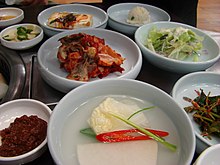

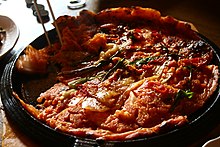


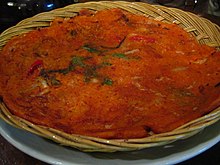
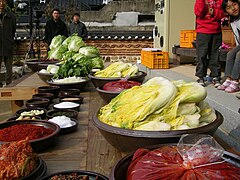
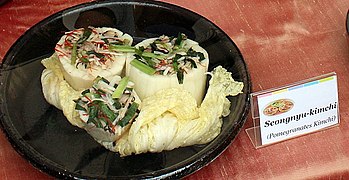


No comments:
Post a Comment